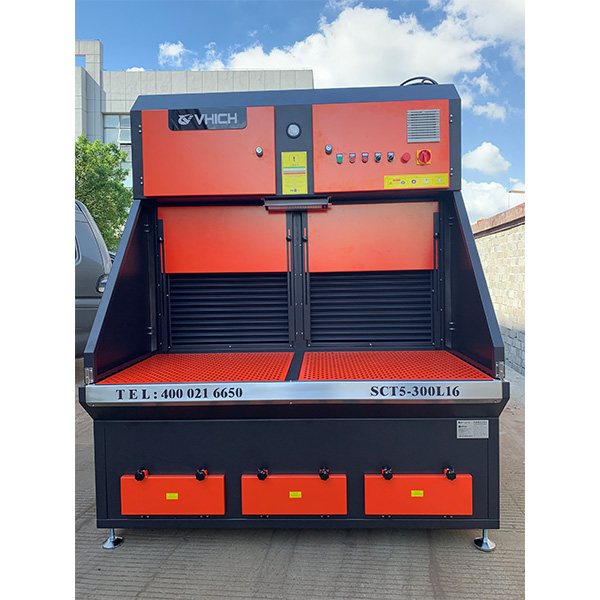
Downdraft tables serve a crucial role in maintaining a clean and safe work environment by capturing and filtering dust, odors, and particulates from processes such as welding, sanding, grinding, and more, ensuring air safety and reducing operator exposure to harmful substances. Their ability to accommodate a wide range of production equipment and comply with OSHA and EPA standards highlights their importance in industrial settings, especially for tasks involving dust collection and air purification.
Designed for versatility, downdraft tables not only enhance operator safety and comfort but also come equipped with high-efficiency filters, facilitating effective air cleansing. As we explore the functionality and significance of downdraft tables in dust collection, we will also guide you through selecting the right downdraft table for your needs, encompassing a variety of applications like deburring, woodworking, and plasma cutting, ensuring a comprehensive approach to maintaining a safe and productive workspace.
Downdraft tables are specialized air filtration systems essential in various industrial applications, designed to enhance safety and cleanliness by capturing airborne contaminants. These tables are equipped with a perforated or grated work surface which allows air to be uniformly drawn through, pulling dust and particles downwards, away from the user's breathing zone. Below this surface, a sophisticated extraction system and multiple layers of filters work in tandem to trap these contaminants, ensuring they do not re-enter the workspace or the external environment.
1.Versatile Use: Downdraft tables are suitable for a wide range of activities including sanding, grinding, cutting, welding, and more, making them a versatile addition to any workshop.
2.Built for Safety: By reducing airborne dust and particulates, these tables significantly lower respiratory risks and contribute to a cleaner work environment.
3.Compliance and Quality: They help facilities meet regulatory standards and improve product quality by maintaining a contaminant-free area.
1.Workbench Design: Often constructed as robust workbenches, these tables can also serve as woodworking stations or assembly areas, integrating seamlessly into the workflow.
2.Customization Options: Features like adjustable pegboard tabletops and specific dust ports cater to custom setups tailored to the user’s needs.
3.Portable and Stationary Models: Depending on the requirement, downdraft tables can be either portable for flexible use or stationary for dedicated tasks.
Incorporating downdraft tables in environments where tasks like welding, grinding, woodworking, and sanding are frequent not only optimizes health and safety but also ensures compliance with industry standards, making them a critical component in modern manufacturing and fabrication setups.
Downdraft tables offer a multifaceted approach to improving air quality and operational safety in environments where dust and particulates are a concern. Here, we explore the numerous advantages these systems provide, particularly in settings involving activities like welding, grinding, and sanding.
1.Effective Filtration: Downdraft tables are engineered to remove virtually all fume and particulate, thereby significantly enhancing the air quality within the workspace [8].
2.Zoned Ventilation: These tables are designed to collect dust and fumes right at the source, particularly effective in applications such as welding and sanding, where particulates are most concentrated.
3.Specialized Features: Models like the DualDraw downdraft tables incorporate patented technologies and design elements like non-sparking fan wheels and a dust tray designed for easy maintenance, aligning with OSHA’s safety recommendations.
1.Ease of Maintenance: The design of downdraft tables allows for easy disposal of collected dust and minimal maintenance, which is crucial in busy industrial settings.
2.ntegrated Systems: By combining a work surface with powerful filtration capabilities, these tables eliminate the need for separate dust collectors and extensive ductwork, streamlining operations.
Downdraft tables are not just beneficial for their primary function of dust collection; they also offer versatility across various applications. Whether it's handling fumes during brazing or capturing dust from buffing and polishing, these tables maintain their efficacy across a broad spectrum of industrial tasks. This adaptability makes them an invaluable asset in diverse working environments, supporting a wide array of processes while ensuring a clean and safe atmosphere.
When selecting the right downdraft table for your needs, consider the specific applications it will be used for, such as welding, grinding, woodworking, buffing, solvent cleaning, sanding, brazing, and polishing. The size of the downdraft table is crucial, as a larger table requires more airflow and a more powerful blower to effectively collect dust. Additionally, the CFM (cubic feet per minute) requirement varies depending on the tasks; for instance, a Denray 7200B has a high CFM, ensuring that particles do not escape during use.
1.Airflow and Size: Ensure the downdraft table is appropriately sized for your workspace and has sufficient airflow for the dust-intensive tasks you perform.
2.System Type: Decide between a dry or wet system based on the materials you work with and the nature of the dust generated.
3.Features for Dust Containment: Look for models that include hoods and barriers to prevent dust escape, especially important in fine dust scenarios like woodworking.
1.User Feedback: Some users may find standard downdraft tables inadequate for dust collection, using them primarily as designated sanding spots, while others praise their effectiveness for specific tasks.
2.Customization: If standard models do not meet your needs, consider custom options such as the Rockler downdraft plates for DIY solutions or adding lift-up side and back panels to enhance the performance with aggressive sanders.
By carefully assessing these factors, you can choose a downdraft table that not only meets your specific requirements but also enhances the safety and efficiency of your work environment.
1.Filter and Grate Maintenance: It's crucial to regularly clean or replace filters and clean the grates on the work surface to ensure the downdraft table operates effectively. Additionally, emptying the dust tray/containment regularly is essential to maintain optimal performance.
2.Motor and Blower Care: Regular checks on the motor and blower are necessary for proper functioning. This may include cleaning, lubrication, or replacing parts as needed.
3.Surface and Spark Trap Cleaning: Keeping the grated surface clean is vital for consistent airflow and preventing the buildup of potentially flammable debris. Cleaning spark traps is also necessary to prevent grime accumulation.
1.Personal Protective Equipment (PPE): Users should always wear appropriate PPE, such as a NIOSH-approved dual cartridge filtered respirator, when using the downdraft table.
2.Compliance with Safety Standards: Adhering to OSHA regulations and handling materials like aluminum dust according to NFPA 484 standards are crucial to avoid fines and ensure a safe working environment.
3.Equipment Use and Care: Ensure the downdraft table is properly grounded to prevent electrical shocks and never use the table for purposes other than its intended use. Regularly check and maintain all safety guards and barriers.
1.Airflow and Ductwork Inspection: Regular checks on airflow and velocity are important to maintain optimal performance. Inspecting the ductwork and exhaust system for blockages or leaks is also crucial.
2.Advanced Cleaning Systems: Employing compressed air filter pulsing mechanisms can significantly extend the life of air filters, and using special vacuum cleaning systems designed for metal powders is recommended for regular cleaning.
3.Systematic Maintenance Logging: Assign specific employees to perform daily and weekly maintenance activities, documenting and logging them systematically to build a "preventative maintenance culture".
1. What is the function of a downdraft table?
A downdraft table is a type of workstation equipped with an integrated vacuum system that captures dust particles, fumes, smoke, or other airborne particulates. These tables are primarily utilized in various processes including woodworking, grinding, finishing, metalworking, welding, plasma cutting, and the fabrication of composites and plastics.
2. How does a downdraft backdraft table enhance safety and cleanliness?
A downdraft backdraft table generates a downward airflow when activated, which helps to prevent debris such as dust and shavings from reaching the user's eyes, nose, or lungs. This airflow also keeps the work area clean and free of particulates, thereby enhancing visibility and cleanliness during tasks.
3. How effective are downdraft tables in removing contaminants?
Downdraft tables are popular for their straightforward operation in extracting fumes and are effective at removing dust and other contaminants from the immediate breathing zone of the worker. However, they are less effective in capturing welding fumes due to the specific characteristics of these fumes.
4. What is the purpose of a dust table?
A dust table, commonly known as a downdraft table, is primarily used to gather dust particles and small debris generated during manufacturing activities such as welding or grinding.
Contact: Tony wu
Phone: +86 13918891309
E-mail: info@vhich.com
Whatsapp:+86-13918891309
Add: Building A1, No.688 North Huan Cheng Road, Nanqiao Town, Fengxian District, Shanghai, China
We chat
